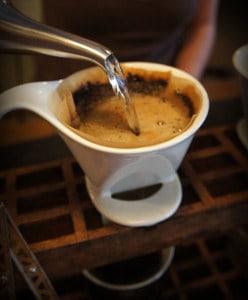
Brewing Method
Drip Coffee, or filtered coffee, is a method which involves pouring water over roasted, ground coffee beans contained in a filter, creating the beverage called coffee. Water seeps through the ground coffee, absorbing its oils and essences, solely under gravity, then passes through the bottom of the filter. The used coffee grounds are retained in the filter with the liquid falling (dripping) into a collecting vessel such as a carafe or pot.
Drip coffee can be obtained using automatic coffee machines, with various degrees of automation. It can also be prepared with manual brewing devices such as coffee drippers, (cones).
Specialty coffee research has determined a set of brewing parameters in order to prepare the perfect cup of drip coffee. These parameters are:
- the brewing temperature, between 195 and 205 degrees Fahrenheit,
- grind size – medium, (900 microns particles),
- brewing time, about 5 minutes
Coffee Filters
Drip coffee uses various filter types. The most popular are the paper filters, which retain most of the volatile oils, creating a clearer beverage with less body. Another popular filter type is the metallic screen filter, which allows most of the coffee oils to pass into the brew. The obtained beverage has a medium body, and it is stronger than the paper filter coffee.
Paper coffee filters were invented in 1908 by Melitta Benz, in Germany. Since then, coffee filters were perfected and there is a variety of sizes, shapes, and thickness, aimed at various coffee makers. In comparison, the screen filter is more uniform. Typically, a coffee maker manufacturer will create a screen filter that is bundled with the coffee machine, but there some aftermarket filter manufacturers.
Coffee Makers
Although drip coffee started as a manual coffee brewing method, automatic drip coffee makers are more popular nowadays because of the convenience. The first automatic coffee machine was invented by Gottlob Widmann in 1954 in Germany. The machine was called Wigomat, and it redefined the coffee brewing industry.
In the ’70s the drip coffee maker was the choice of coffee lovers, replacing the percolator, which has a tendency to over extract coffee. Until the 70s, the percolators were the choice at the time for batch coffee brewing.
The manual dripper has gained back some of its original popularity in the last years. This popularisation was caused by the third wave coffee current, which treated coffee as an artisanal product, and not an industrial one.
Popular drippers are Chemex, Hario V60, Kalita, Melitta, Bonavita. These drippers are different, and their features make them appealing to various sections of the market. To point out the best coffee dripper is a difficult task, since the coffee they produce is different.